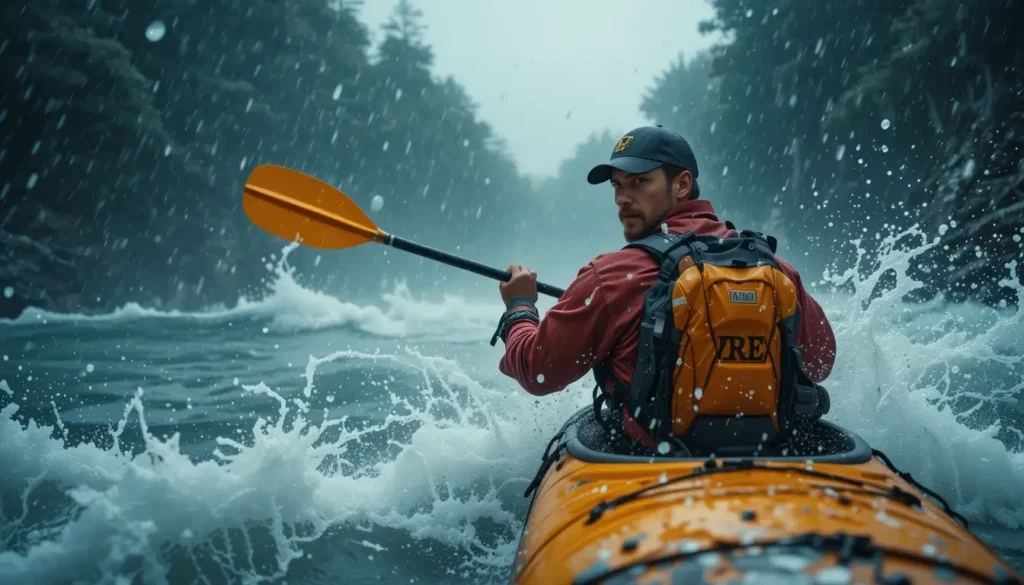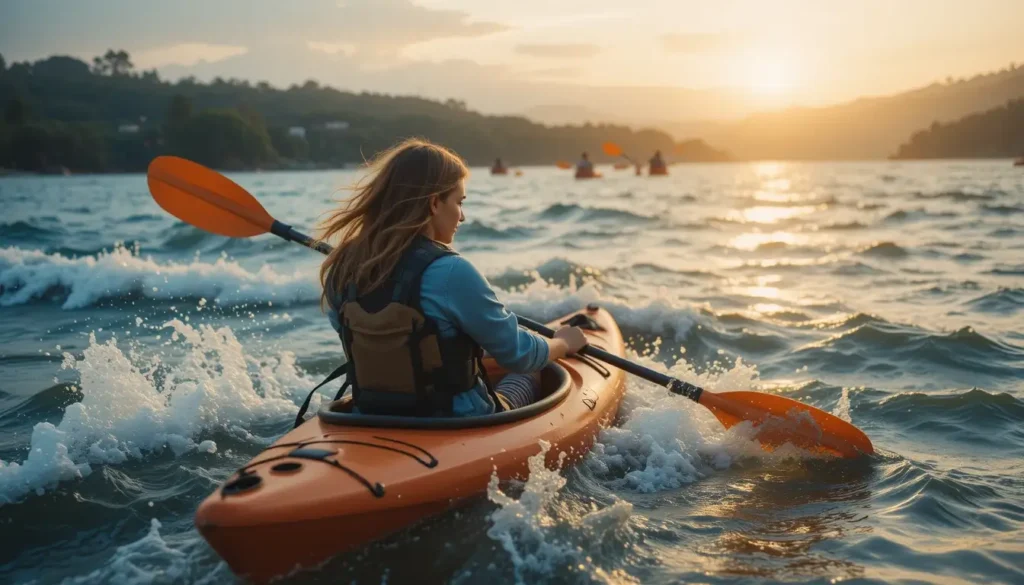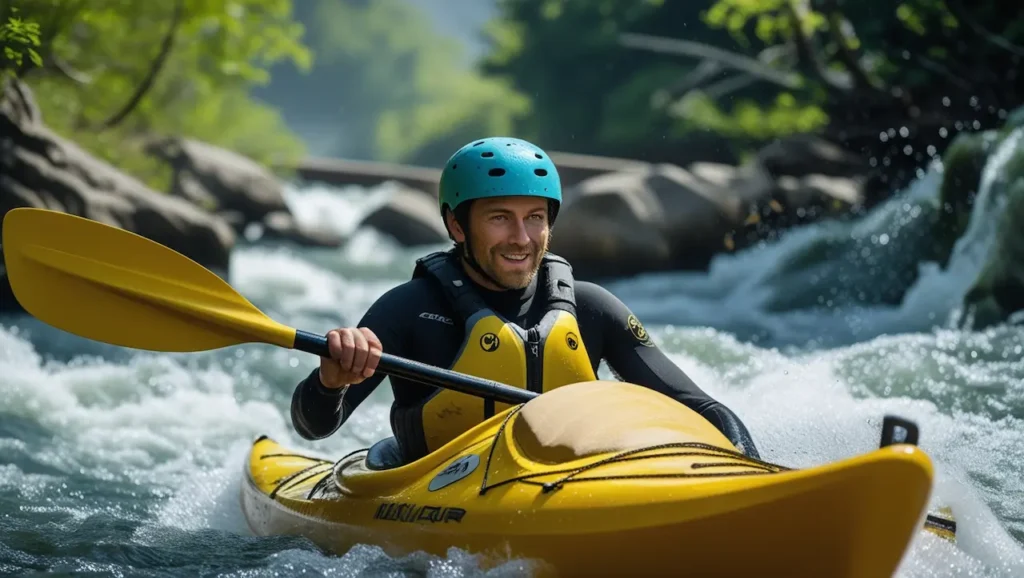Kayaking in extreme weather pushes you beyond calm waters and gentle breezes. It tests your skills, your gear, and your mindset. Facing strong winds, heavy rain, or cold temperatures is a challenge many avoid.
Yet, those who prepare carefully find it thrilling and rewarding. Knowing how to stay safe in tough conditions is key. This article will guide you through smart tips to keep you secure when nature shows its wild side.
Understand the Risks and Prepare Mentally
When the weather turns harsh, the dangers you face increase quickly. Waves become bigger and stronger, making it hard to keep your kayak steady. Wind can push your kayak off its path, forcing you to paddle harder to stay on course.
Heavy rain reduces visibility, so it is harder to see hazards like rocks, other boats, or sudden changes in water. Cold water drains your energy faster, and if you fall in, hypothermia can set in quickly. These factors create a dangerous mix that challenges even experienced paddlers.
Ignoring these risks or underestimating them can lead to serious accidents. Many paddlers get into trouble because they assume they can handle the conditions without proper preparation.
Understanding what extreme weather means on the water is your first defense. This means learning how wind, waves, rain, and temperature affect your kayak and your body. It also means knowing your limits and recognizing when the conditions are beyond your skill or comfort level.
Physical preparation is important, but mental readiness is just as critical. When bad weather hits, fear and panic can take over if you are not mentally prepared. Panic can cause poor decisions such as overexertion or freezing up.
These reactions waste energy and make problems worse. Before you go out, spend time practicing ways to stay calm under pressure. Breathing exercises, visualization, or simple mindfulness techniques help control anxiety.
Plan your trip carefully. Study your route and identify safe spots where you can take shelter or exit the water if conditions worsen. Know where to go in an emergency. This kind of planning reduces stress and gives you a clear path to safety.
Tell someone on land about your plan, your expected return time, and your route. This step is critical because if something goes wrong, rescue teams will know where to look.
Keep in mind that even experienced paddlers can make mistakes if they are not mentally ready. Confidence without caution can lead to dangerous choices. Respect for the power of nature and honesty about your skills will keep you safer.
Part of mental preparation is also being ready to change plans. If the weather changes suddenly, be willing to turn back or seek shelter.
Practicing safety drills regularly helps prepare your mind and body for emergencies. Try wet exits, self-rescue, and assisted rescue techniques in controlled conditions. The more familiar you are with these skills, the less likely you are to panic if you capsize. Your mind will know exactly what to do, which reduces stress and saves energy.
Check Weather Forecasts and Choose Your Gear Wisely
Before you launch your kayak, the first rule in extreme weather is to know what to expect. Weather conditions on the water can change quickly and without warning. Checking the forecast thoroughly can help you avoid surprises.
Start by reviewing local weather reports from trusted sources. Pay attention to wind speed, wave height, precipitation, and temperature changes. Some apps and websites provide specialized marine weather data, which is often more accurate for paddlers.
Using multiple sources is better than relying on just one report. Different providers may offer updated or slightly different information. Cross-checking data gives you a clearer picture. Watch for warnings about storms, high winds, or rough seas.
If any part of the forecast suggests dangerous conditions, consider postponing your trip. Staying on shore is a smart and sometimes life-saving choice.
Once you decide to paddle in difficult weather, choosing the right gear is essential. Not all kayaks handle rough conditions equally. A kayak designed for open water or rough seas will be longer, more stable, and easier to control in waves. Avoid recreational kayaks meant only for calm lakes or slow rivers when weather turns bad.
Personal safety equipment is your next priority. Always wear a personal flotation device (PFD) that fits properly and meets safety standards. Your PFD must be comfortable enough to wear all the time and allow you full range of motion. It is your best protection if you fall into the water.
What you wear matters more in cold or wet weather. Dress for the water temperature, not just the air. Cold water can cause hypothermia quickly. Wet suits or dry suits provide insulation and protect you from shock if you capsize. Layering with moisture-wicking fabrics keeps you warmer. Avoid cotton clothing, which traps water and lowers your body temperature.
Additional gear improves your chances of rescue if needed. A whistle attached to your PFD helps you signal for help. Waterproof communication devices, such as marine radios or waterproof phones in sealed cases, allow you to call for assistance. Bring a paddle leash so you don’t lose your paddle in strong waves.
Do not forget other safety items like a bilge pump or sponge to remove water from the kayak. A spray skirt, which fits tightly around the cockpit, prevents waves from filling your kayak. These small details improve safety and comfort in rough conditions.
Before setting out, check all your gear carefully. Make sure your kayak is in good condition with no leaks. Test your PFD and other equipment to ensure everything works. Plan to carry extra food, water, and warm clothes in a dry bag in case you get delayed or stranded.
Master Launching, Landing, and Paddling Techniques
Launching and landing a kayak in extreme weather requires extra attention and care. When waves are strong, they can easily push your kayak into rocks, docks, or other hazards near the shore.
These moments are some of the most dangerous because the kayak is less stable on uneven ground or crashing waves. Look for sheltered areas that have less current or smaller waves to start and end your trip. Avoid places where waves hit directly or where strong winds funnel water toward the shore.
When launching, move slowly and keep your balance steady. Step carefully into shallow water while holding your paddle firmly. If you have a partner, ask for help.
They can hold your kayak steady or watch for sudden waves. Avoid rushing because a sudden wave or slip can tip your kayak over immediately. Take your time to feel the water and the kayak’s stability before fully pushing off.
Landing is just as tricky. Approach the shore at a slow pace and angle your kayak to face the waves head-on. This reduces the chance of waves hitting you from the side and capsizing your kayak. Use your paddle as a brace to keep balance as you come ashore.
If possible, get out where the water is shallow and calm, and never jump out too early. Watch your footing carefully as rocks and wet surfaces can be slippery.
Paddling techniques become even more important in harsh weather. Use short, strong paddle strokes to maintain control and move steadily. Long, slow strokes can leave you vulnerable to waves or wind pushing you off balance.
Keep your paddle close to the kayak so it can help you stabilize. Adjust your body position by leaning slightly into the waves or wind to counter their force. This small shift helps prevent tipping.
Look ahead constantly, not down at your paddle or the kayak. This helps you spot upcoming obstacles like floating debris, rocks, or other boats. Staying alert allows you to react early and avoid trouble. When the wind blows hard, you may get pushed off course.
Paddle at an angle against the wind to fight back rather than pushing directly into it. This conserves energy and keeps your kayak stable.
Avoid sudden or jerky movements. Quick turns or strong paddle strokes without control can destabilize your kayak and lead to capsizing. Practice smooth, deliberate strokes and maintain a steady rhythm. Use your core muscles to turn and brace rather than relying only on your arms. Strong core control improves balance and endurance.
Recognize Physical Signs and Know What to Do in Emergencies
Extreme weather pushes your body harder than usual, and knowing how to spot signs of trouble is essential. One of the biggest risks is hypothermia, which can set in when your body loses heat faster than it can produce it.
Cold fingers, numbness, and shivering are early warning signs. If you notice these, it is time to slow down and find a way to warm up. Your reaction times may slow, and your muscles can become stiff, making it harder to paddle or respond to dangers.
Fatigue is another warning. If you feel tired or weak, take breaks on safe, calm shores. Paddling while exhausted increases the chance of mistakes and accidents. Drink water regularly to avoid dehydration.
Dehydration can happen even in cold weather because your body still loses fluids through sweat and breathing. Avoid drinking alcohol or caffeine before and during your trip. Both can impair your judgment and reduce your body’s ability to regulate temperature.
If you capsize in rough weather, your reaction will matter more than ever. The first step is to stay calm. Panic wastes energy and makes it harder to think clearly. Hold onto your paddle and kayak if possible. Your kayak floats and can act as a life raft.
If you learned how to roll your kayak back upright, try this if conditions allow. Practicing this maneuver before heading into rough waters can save your life.
If you cannot roll up, swim calmly to shore or to a safe area. Use your whistle or any signaling device to attract attention. Cold water shock can be dangerous. It causes rapid breathing, muscle spasms, and can lead to drowning if you panic.
Focus on controlled breathing and keep your head above water. If you get help nearby, signal immediately.
Prepare for emergencies by practicing rescue techniques regularly. Know how to self-rescue and how to assist others. Carry a waterproof communication device so you can call for help if needed. Pack a first aid kit in your dry bag for minor injuries. The more prepared you are, the less stressful an emergency becomes.
Plan Smartly and Learn from Experience
Timing your trip right can reduce many risks associated with extreme weather kayaking. Early mornings or late evenings often have calmer winds and less boat traffic. This makes it easier to control your kayak and see what is around you.
Sunlight helps you identify waves, currents, and obstacles more clearly. Avoid kayaking during storms or if lightning is nearby. These conditions can turn dangerous very fast. If the weather suddenly worsens while you are out, do not hesitate to head to shore immediately. Always put your safety above any goal or adventure.
Experience is the best teacher. Start by practicing kayaking in calm and moderate conditions. Build your skills step by step before trying rough weather.
Join a kayaking club or take lessons focused on handling challenging environments. Experienced paddlers can share valuable tips and correct mistakes you may not notice yourself. Learning from others shortens your learning curve and improves your confidence.
Training in a variety of conditions develops muscle memory for emergencies. When rough waves hit, your body and mind react automatically based on what you have practiced.
This helps you stay calm and act correctly under pressure. Over time, your endurance and strength improve, allowing you to paddle longer and handle tougher weather.
Keep a journal or log of your trips. Note what conditions you faced, what worked well, and what problems arose. Review this information to learn from mistakes and successes. Adjust your preparation and gear accordingly. This ongoing learning process makes you a smarter, safer paddler.
Remember that even experienced kayakers make mistakes. The key is to learn from each trip and improve. Respect the power of the weather and water. Know your limits honestly and do not push beyond them.
Accept that some days are better spent on shore. Being patient and cautious extends your kayaking career and keeps you safe.
Extreme weather kayaking is not for everyone. It demands respect for nature and honest self-assessment. Knowing when to push forward and when to turn back saves lives.
With the right knowledge, gear, and attitude, you can enjoy the challenge without unnecessary danger. Every trip teaches you something new and deepens your respect for water.
In the end, your safety is in your hands. Prepare well, stay alert, and respect the forces around you. Extreme weather can test your limits but also reward your effort with unforgettable experiences.
Kayaking is a powerful way to connect with nature’s power, if done wisely. Use these tips to make every paddle safe, smart, and successful.




